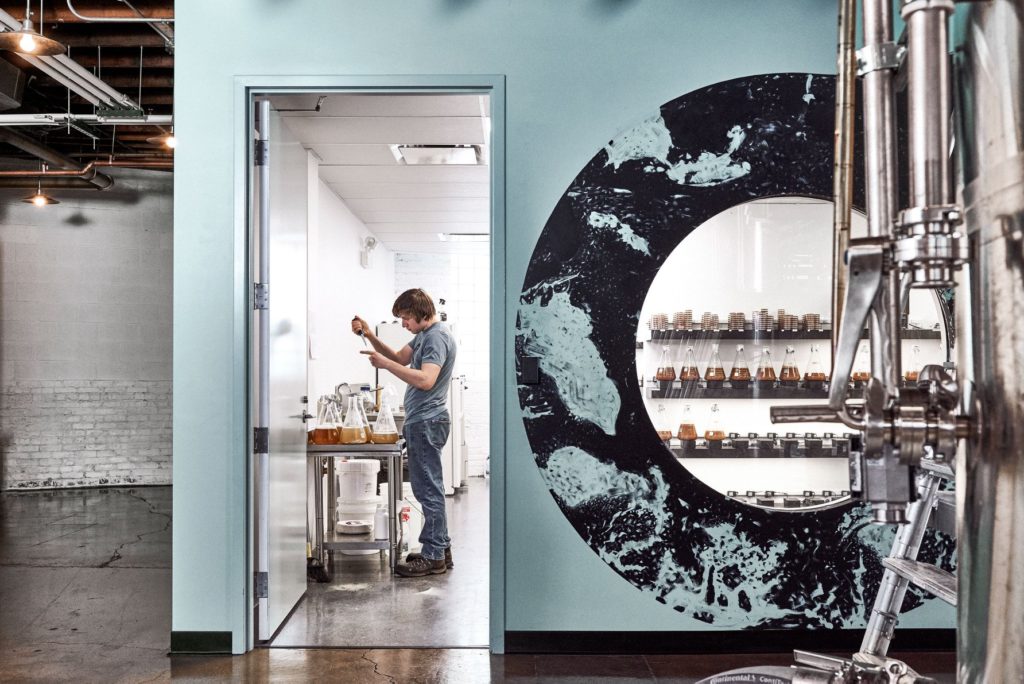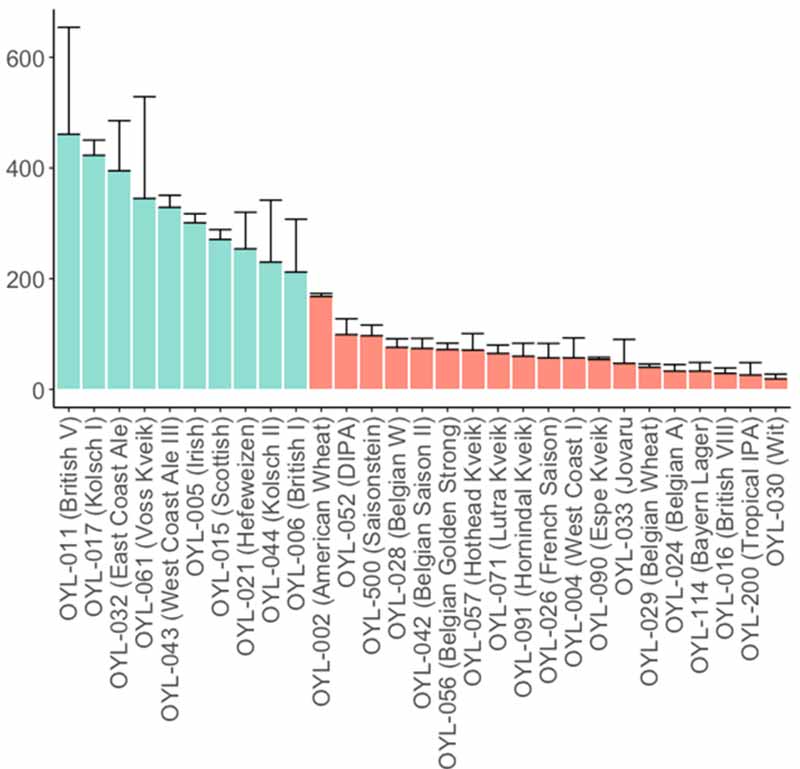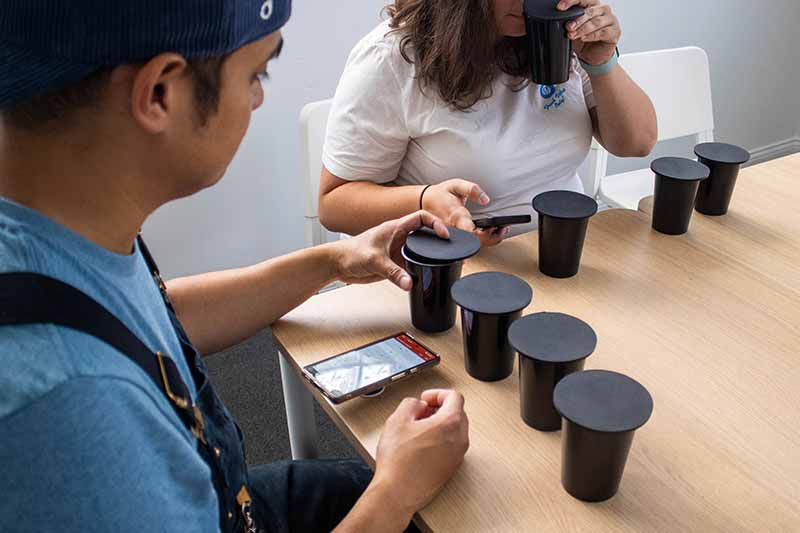
Over the summer, Omega Yeast released groundbreaking research linking hazy beer to a specific hazy beer gene called HZY1. Their findings can help brewers peel back the layers even more on one of America’s most popular beer styles.
Undoubtedly, craft beer consumers love IPAs. All the analytics point toward that fact, with IPAs dominating the charts from 2021 Untappd data, where IPAs nabbed four out of the top five checked-in styles, and then again in 2022, with IPAs in the top four spots on the list.
For the past two years, hazy IPAs held strong among the IPAs checked in by Untappd users, with New England-style IPAs consistently claiming the number two spot.
Already known for driving much of the research behind thiolized yeast, Omega Yeast’s probes into HZY1 can give brewers the tools to maximize the uber-popular hazy IPA with their consumers. Omega’s Director of Research and Development, Laura Burns, and Old Irving Brewing Co-Founder and Head Brewer Trevor Rose-Hamblin, who helped in the trials of HZY1, explain what the gene is, how to accentuate it, and the benefits it brings to your beer.
(Above Graphic courtesy of Omega Yeast)
Affordable, Industry-Leading Brewery Software
What Is the Hazy Beer Gene HZY1?

Graphic courtesy of Omega Yeast
Burns says Omega Yeast found that certain yeasts have a particular protein, or gene, in them that directly links to creating haze—if used correctly.
Prior to Omega Yeast’s research, most attributed haze in a beer to the effect of malt or hops but not a very specific gene in yeast.
“We did sequencing and honed in on a hazy gene, chromosome nine, which was unknown,” Burns said. “Before that, no one had any idea this was happening. … We named it HZY1 for its involvement in haze.”
How Did Omega Yeast Develop the Hazy Beer Gene HZY1?

Photography courtesy of Omega Yeast
Always at the forefront of R&D, Omega Yeast constantly experiments with yeast under different conditions and fermentation temperatures.
“In one case, we were using a simple experiment to mimic IPA fermentations, and we found that certain yeast strains would promote haze when others did not,” Burns shared in a press release.
It wasn’t even something they were specifically looking into at the time.
“[But] it was an ‘A-Ha!’ moment when we were studying dry hop creep,” Burns says. “We could see no haze and haze between two strains. Everything was the same except [for] the yeast strains.”
She says that her team looked at two similar strains side by side, meeting them to the point where they were similar and isolating the gene that caused one strain to create haze and the other to not.
Burns says that chromosome nine explained what the gene does: creates haze in beer. They started to connect the dots, she says.
The Omega Yeast team then split strains into “haze positive” and “haze neutral” categories. Burns shares a chart (see below) that shows ten haze-positive yeast strains, most notably OYL-011, a British V strain, and nineteen haze-neutral strains—though they continue to test strains and that the number of haze positive and neutral strains are not absolute.
She adds that the strains have an expanding region of glycosylation and potentially high levels of proteins contributing to the haze.
“In the past, yeast mannoproteins have been associated with haze in beer and wine,” Burns says. “We were able to find the specific mannoprotein, HZY1, that makes certain brewing strains haze-positive.”
Burns adds that while no one in the past had uncovered this gene and its role in haze, there were some who predicted yeast mannoproteins were involved in making haze in beer.
“But more in situations where yeast were stressed or sheered, and not in hazy IPAs,” she says.
Which Yeast Strains Contain the Hazy Beer Gene HZY1?

Chart courtesy of Omega Yeast
In addition to the British V, Omega Yeast identified the following as haze positive:
- OYL-017 Kolsch I
- OYL-032 Coast Ale
- OYL-061 Voss Kveik
- OYL-043 Coast Ale III
- OYL-005 Irish
- OYL-015 Scottish
- OYL-021 Hefeweizen
- OYL-044 Kolsch II
- OYL-006 British I
Burns explains how they define haze positive.
“[Haze positive strains] fit our criteria of making haze in beer with late dry hop additions [more than 200 NTUs],” she says.
Burns says that the 200 NTUs is what many people would consider a cut-off for light haze in a pale ale or low range for a hefeweizen.
The chart above shows the haze each strain makes in a two-pound-per-barrel dry-hopped beer.
“Later in the study, we found that many of these haze-positive strains have a larger version of the HZY1 gene,” Burns says.
She adds that the gene has not shown to release any discernible flavor notes in the beers they’ve experimented with, though the strains themselves release their typical flavor notes, to add additional character to your beer.
“Because we can very specifically get rid of haze by deleting the gene, we haven’t found ‘haze’ or ‘the HZY1 gene’ to lead to any differences in flavor,” she says. “More testing will be needed to fully understand the association with this yeast-derived haze and overall beer flavor/mouthfeel.”
Burns explains that it’s not that other strains don’t also have the gene, but that the haze-positive strains have something the others don’t.
Why Does the Hazy Beer Gene HZY1 Matter?

Photography courtesy of Omega Yeast
Understanding which yeast strains cause haze and editing them accordingly can help brewers explore new flavor combinations, especially between their New England-style and West Coast or American IPAs, or simply understand how to make their hazy beers…hazier.
For instance, Old Irving Brewing’s Rose-Hamblin says Omega approached him about participating in their R&D work. They asked him to add a haze-positive yeast strain, OYL-011, with the hazy gene HZY1 removed, to his Beezer Hazy IPA.
The goal?
“They wanted to test on a larger scale than their own small brewing system at Omega,” Rose-Hamblin says. “They also wanted to be able to have the same beer side by side, brewed in the same conditions with all of the same ingredients and the only variable being the removal of the HZY1 gene and note any changes in flavor and appearance.”
So what did Omega learn from the experiment?
“The result was a ‘Crystal Beezer’ that looked very different but tasted very similar,” Burns says. “You can get rid of haze if you get rid of the gene.”
Rose-Hamblin confirms that the normally hazy beer turned out clear. “In a blind test where you couldn’t see the beer, it was hardly discernible.”

Photography courtesy of Omega Yeast
Rose-Hamblin said they released the experimental beer as part of a brew lab series they make when they partner with Omega during their R&D process.
Consumers were into the Beezer Clear, he says.
“It’s rare that you get a perfectly clear beer. You could juice it a little bit for sure,” he says of adding the OYL-011 with the HZY1 removed. “It did really well; people really enjoyed it. For this particular experiment it was quite exciting.”
The discovery of what this gene can do excites Rose-Hamblin for future brews.
“I’m looking forward to putting it in some of these yeast strains that clear things out,” he says. “It opens an abundance of opportunities with other beers.”
He says they double dry hopped Beezer and had all of the haze-producing variables other than the gene itself. But Rose-Hamblin wonders what the future of beers—clear and hazy—can be.
“If the point of the hazy IPA’s original identity was haze as a result of all of these lovely fruit flavors that come from the brewing process, does it need to be hazy?” Rose-Hamblin says. “It pushes one to wonder if…the minutiae between hazy flavor and physical haze could really broaden the spectrum of both clear and hazy IPAs.”
What Is the Best Way to Use Yeast Strains With the Hazy Beer Gene HZY1?

Photography courtesy of Omega Yeast
With dry hopping. But not just any dry hopping. For the hazy beer gene HZY1 to work, the dry hop has to be later in the fermentation of post-fermentation.
“We see that early [dry hop] addition leads to no haze or less haze,” Burns says. “Even in combination with a late dry hop that would normally result in haze.”
Burns stresses that if you want to get more haze, you must use one of the haze-positive strains and a late dry hop. If you want to double dry hop, she says to do mid- to late dry hopping, followed by another later. And eliminate early dry hop.
“It’s a standard approach,” Burns says. “When you want haze, just pair [a haze-positive strain] with a dry hop.”
With the research still in its infancy, brewers have the opportunity to take this information and run with it. For Rose-Hamblin, he is excited to do more with the strains.
“The most exciting part about this is that there’s a diverse range of yeast strains out there that produce different flavors,” he says. “This gene is adding a few more colors to my crayons. It gives us more creative runway to kind of diversify our styles.”



